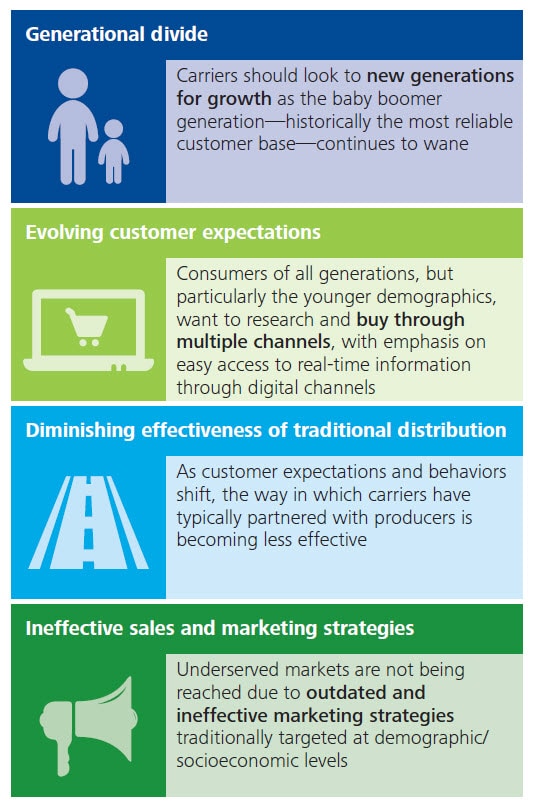Life insurance consumer purchase behavior has been saved

Perspectives
Life insurance consumer purchase behavior
Tailoring consumer engagement for today’s middle market
Deloitte surveyed over 1,700 middle market buyers and non-buyers of life insurance in the US to understand how life insurance companies might better equip themselves to effectively reach an underserved market segment. The study uncovered numerous insights and trends that could help carriers and agents better engage customers to drive growth.
A changing industry and evolving consumer base
Over the past five years, the individual life insurance industry has experienced slowed growth in the face of economic headwinds and frequent marketing ineffectiveness. Though industry growth remains sluggish, the economy is bouncing back, resulting in decreasing unemployment, and increasing consumer confidence. Further, interest rates remain low in an effort by the government to encourage discretionary spending. As a result, many consumers have indicated a renewed desire to purchase financial products, with life insurance representing one of the ripest areas for potential growth.
Most current carrier models seem to focus on adapting existing go-to-market strategies to a digital marketplace. Our study suggests that the life insurance ‘winners’ of tomorrow will likely be those organizations that blend an advice-driven approach with a digitally enhanced engagement strategy to help meet evolving consumer expectations.

Importance of life events and communication channels
High impact life events motivate purchase
In particular, it can be beneficial to understand life events core to each stage of a person’s life. These range from standard events such as marriage and children to less common ones, including natural disaster and gaining ones’ citizenship. While all impact purchase behavior, certain events are significantly more impactful in driving consumer purchase.
The most impactful events where a high percent of surveyed buyers indicate importance include:
- Having children (43 percent)
- Buying a home (35 percent)
- Change in financial situation (33 percent)
- Marriage (28 percent)

Understanding the importance of these life events should shape the timing, channel, and messaging of marketing to better speak to specific consumer needs and mindsets. Lead identification as well as current sales and marketing messages are largely based on the assumption that selling starts with the agent, when in reality it starts with life events—which are often not adequately understood.

Adapt go-to-market strategies to overcome common challenges
To help reignite consumer appetites, carriers should adapt their go-to-market strategies, while working to overcome some common challenges:

Most current carrier models seem to focus on adapting existing go-to-market strategies to a digital marketplace. Our study suggests that the life insurance ‘winners’ of tomorrow will likely be those organizations that blend an advice-driven approach with a digitally enhanced engagement strategy to help meet evolving consumer expectations.

Accessing this market is important to long-term effectiveness
Carriers may have a particular opportunity to unlock a significantly underserved market. Life insurance is important, and those consumers that have had or know the experience of collecting insurance proceeds can likely attest to the benefits. Unfortunately, the importance of life insurance remains under-appreciated. Those carriers that reach consumers at the right time; connect the dots between the emotion of a life event and the value of life insurance; and engage consumers in a way that marries advice with digital capabilities will likely be the front-runners to capture nearly $15 trillion in unmet need and grow faster and healthier than their peers.
Contacts
If you have questions regarding this report, please contact any of the following Deloitte Consulting LLP professionals:
- David Hitsky, principal, Deloitte Consulting LLP
- Stacy Hodgins, senior manager, Deloitte Consulting LLP
- Chin Ma, manager, Deloitte Consulting LLP
